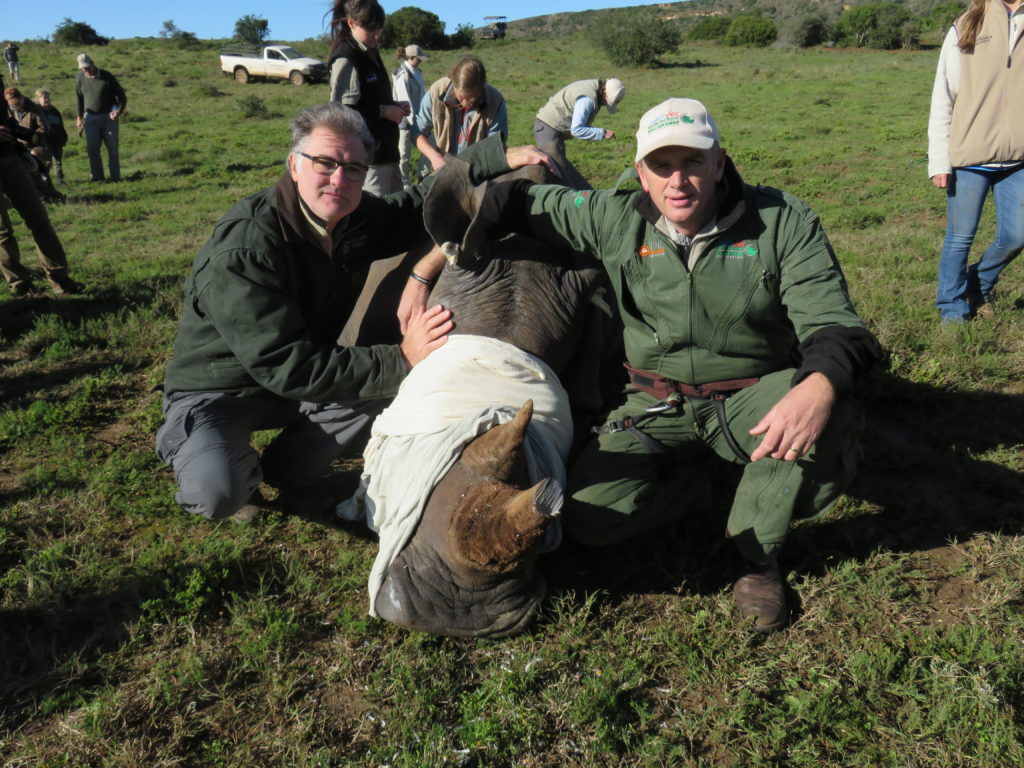The killing of Cecil the lion in Zimbabwe last year garnered worldwide media attention, but its death is just the tip of the iceberg when it comes to the tens of thousands of animals felled by poaching each year.
However, a challenger to the global issue is emerging in Fort Worth, where a Texas Christian University professor has been leading a fight to end brutal killing of the African rhino.
Michael Slattery, a professor in the School of Geology, Energy & the Environment and director of the Institute for Environmental Studies at the Fort Worth university, is co-founder of the TCU Rhino Initiative, a global partnership dedicated to saving the endangered animal.
Rhino poaching presents a pressing problem: Several subspecies are extinct, and others are critically endangered. Once abundant throughout Africa and Asia, wild populations have dropped to 25,000 from a peak of 100,000 in the mid 20th century.
Rhinos have been in existence in their current form for over 50 million years, representing an uncommon biological link to the planet’s past. “The rhino is truly our last living link to the dinosaurs,” Slattery said.
Poaching is driven by the illegal trade of the rhino horn, fueled by a growing demand in Asian countries, especially Vietnam.
“Rhino horn has been used in traditional Asian medicine as an elixir for fevers for over a thousand years, but demand up until the mid-2000s was fairly limited,” Slattery said.
Rhino horn powder was removed from Chinese herbal pharmacopeia in the 1990s. This, along with trade bans, cut demand for a time.
“Modern science has proven that these coveted horns carry no medicinal value whatsoever, as they are nothing more than compressed hair,” Slattery said.
In the early 2000s, however, rhino horn took on a more sinister draw as a symbol of wealth in Southeast Asia, fueled by specious rumors of its health benefits.
“Rhino horn has now become such a status symbol that consumers readily, though illegally, pay upwards of $6,000 to $10,000 per 100 grams,” said Slattery. As a hedonistic luxury item, rhino horn is also viewed as a party drug and virility enhancer.
“At these prices, horn is more expensive than gold and cocaine, which has attracted the involvement of organized crime syndicates with access to sophisticated military-grade equipment and resources to more effectively track down and kill rhinos,” Slattery said.
In 2014 alone, the Department of Environmental Affairs reported that poachers killed 1,215 rhinos. Their methods are often brutal, sometimes leaving the animal to bleed to death after hacking off the horn.

Dr. Michael Slattery (L) and Dr. William Fowlds (R) upon the completion of a white rhino collaring and DNA sampling procedure in the Eastern Cape, South Africa.
As a geographer and environmental scientist interested in human impact on the environment, Slattery admits that zoology is not his primary area of study, though he felt compelled to address the poaching issue.
“I am not a rhino expert,” he said. “However, as an environmental scientist, I do believe we have special duties and responsibilities toward other species.” The pressing issues surrounding the animal seemed a perfect place to start.
Together with South African veterinarian William Fowlds, he formed the TCU Rhino Initiative, a program focused on ensuring the rhino’s long-term survival.
By leveraging TCU’s Global Innovator Program, which brings together the university and scholars working across the planet, Slattery connected with Fowlds and used a grant to bring him in April 2014 to Fort Worth, where Fowlds lectured on campus and around the city about the poaching crisis.
Their agreed-upon approach is multifaceted to best address the global issue.
“We are helping on several fronts, from organizing demand reduction campaigns and raising public awareness through TCU’s Vietnamese Students Assn. to supporting protection and rescue initiatives on the ground, where poached rhinos can be rehabilitated and eventually function again in wild habitats,” Slattery said.
TCU students also are traveling to South Africa as part of the university’s Biodiversity and Human Development course, where they help develop strategies to solve the rhino crisis.
In partnership with several South African organizations, the TCU Rhino Initiative is also beginning work on a collaborative education, research and protection center. The facility, known as the African Rhino Community Center, will enhance the protection of the animals as part of the Amakhala Game Preserve and hopes to roll out support for three subspecies of black and white rhinoceros across the region.
In addition to providing anti-poaching support and veterinary care, Slattery said that the center would offer “research and innovation to inform the development of an effective restoration and recovery plan and community outreach.”
While the center is taking steps to help, the poaching crisis remains complex, with many different attitudes about what we, as a species, owe the planet.
Slattery feels there is no room for debate. “Do we have special duties and responsibilities toward other species and the natural world?” he asked.
“Absolutely, we do. We cannot afford to lose this species.”
